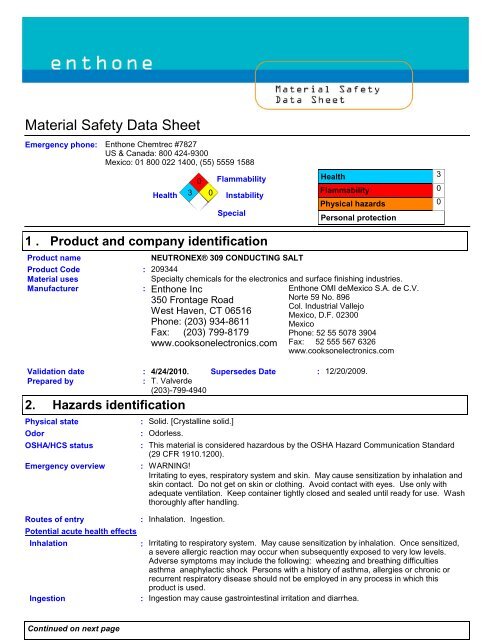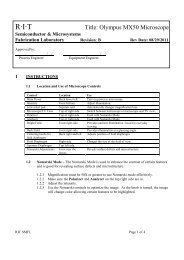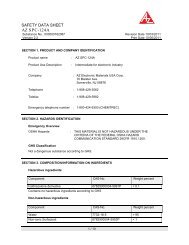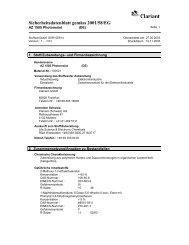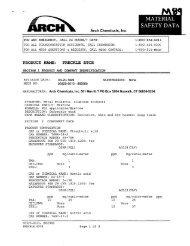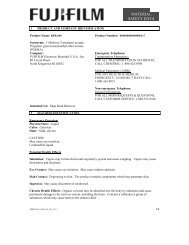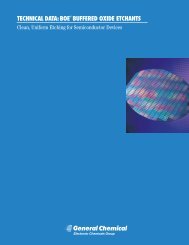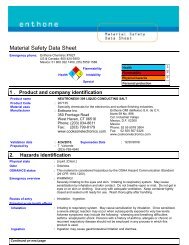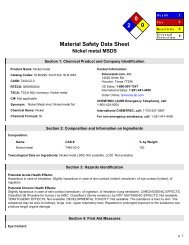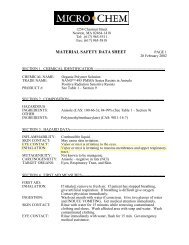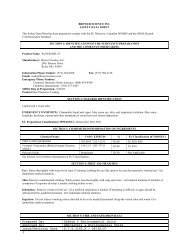7468 NEUTRONEX 309 CONDUCTING SALT (English (US ... - SMFL
7468 NEUTRONEX 309 CONDUCTING SALT (English (US ... - SMFL
7468 NEUTRONEX 309 CONDUCTING SALT (English (US ... - SMFL
- No tags were found...
Create successful ePaper yourself
Turn your PDF publications into a flip-book with our unique Google optimized e-Paper software.
Enthone is a subsidiary ofCookson Group PLC4 .First aid measuresProtection of first-aiders5 .Fire-fighting measuresFlammability of the product :Extinguishing mediaSuitable :Not suitable :Special exposure hazards :Hazardous combustionproductsSpecial protectiveequipment for fire-fighters6 .<strong>NEUTRONEX</strong>® <strong>309</strong> <strong>CONDUCTING</strong> <strong>SALT</strong> Page: 3/7: No action shall be taken involving any personal risk or without suitable training. It maybe dangerous to the person providing aid to give mouth-to-mouth resuscitation. Wearsuitable protective clothing, gloves and eye/face protection. If it is suspected that fumesare still present, the rescuer should wear an appropriate mask or self-containedbreathing apparatus. Wash contaminated clothing thoroughly with water beforeremoving it, or wear gloves.No specific fire or explosion hazard.Use an extinguishing agent suitable for the surrounding fire.None known.Promptly isolate the scene by removing all persons from the vicinity of the incident ifthere is a fire. No action shall be taken involving any personal risk or without suitabletraining.: sulfur oxidesmetal oxide/oxides: Fire-fighters should wear appropriate protective equipment and self-contained breathingapparatus (SCBA) with a full face-piece operated in positive pressure mode.Accidental release measuresPersonal precautions :Environmental precautionsLarge spill :Small spill :7 .HandlingStorageHandling and storageContinued on next pageNo action shall be taken involving any personal risk or without suitable training.Evacuate surrounding areas. Keep unnecessary and unprotected personnel fromentering. Do not touch or walk through spilled material. Provide adequate ventilation.Wear appropriate respirator when ventilation is inadequate. Put on appropriate personalprotective equipment (see section 8).: Avoid dispersal of spilled material and runoff and contact with soil, waterways, drainsand sewers. Inform the relevant authorities if the product has caused environmentalpollution (sewers, waterways, soil or air).::Move containers from spill area. Approach release from upwind. Prevent entry intosewers, water courses, basements or confined areas. Vacuum or sweep up materialand place in a designated, labeled waste container. Dispose of via a licensed wastedisposal contractor. Note: see section 1 for emergency contact information and section13 for waste disposal.Move containers from spill area. Vacuum or sweep up material and place in adesignated, labeled waste container. Dispose of via a licensed waste disposalcontractor.Put on appropriate personal protective equipment (see section 8). Eating, drinking andsmoking should be prohibited in areas where this material is handled, stored andprocessed. Workers should wash hands and face before eating, drinking and smoking.Persons with a history of skin sensitization problems or asthma, allergies or chronic orrecurrent respiratory disease should not be employed in any process in which thisproduct is used. Do not get in eyes or on skin or clothing. Do not ingest. Use only withadequate ventilation. Wear appropriate respirator when ventilation is inadequate. Keepin the original container or approved alternative container. Containers should be keptclosed when not in use. Empty containers retain product residue and can be hazardous.Do not reuse container.Store in accordance with local regulations. Store in original container protected fromdirect sunlight in a dry, cool and well-ventilated area, away from incompatible materials(see section 10) and food and drink. Keep container tightly closed and sealed until readyfor use. Containers that have been opened must be carefully resealed and kept uprightto prevent leakage. Do not store in unlabeled containers. Use appropriate containmentto avoid environmental contamination.
Enthone is a subsidiary ofCookson Group PLC<strong>NEUTRONEX</strong>® <strong>309</strong> <strong>CONDUCTING</strong> <strong>SALT</strong> Page: 4/77 .8 .Handling and storageKeep container tightly closed. Keep container in a cool, well-ventilated area.Exposure controls/personal protectionConsult local authorities for acceptable exposure limits.Recommended monitoringproceduresEngineering measuresHygiene measuresPersonal protectionRespiratoryHands :EyesSkinEnvironmental exposurecontrols: If this product contains ingredients with exposure limits, personal, workplace atmosphereor biological monitoring may be required to determine the effectiveness of the ventilationor other control measures and/or the necessity to use respiratory protective equipment.: Use only with adequate ventilation. If user operations generate dust, fumes, gas, vaporor mist, use process enclosures, local exhaust ventilation or other engineering controlsto keep worker exposure to airborne contaminants below any recommended or statutorylimits. Processes should be designed to minimize airborne and skin exposure tohazardous substances.: Wash hands, forearms and face thoroughly after handling chemical products, beforeeating, smoking and using the lavatory and at the end of the working period. Appropriatetechniques should be used to remove potentially contaminated clothing. Washcontaminated clothing before reusing. Ensure that eyewash stations and safety showersare close to the workstation location. Eating, drinking and smoking should be prohibitedin areas where this material is handled, stored and processed. Remove/Take offimmediately all contaminated clothing. Contaminated work clothing should not beallowed out of the workplace.:::Use a properly fitted, air-purifying or air-fed respirator complying with NIOSH if a riskassessment indicates this is necessary. Respirator selection must be based on knownor anticipated exposure levels, the hazards of the product and the safe working limits ofthe selected respirator.Chemical-resistant, impervious gloves complying with an approved standard should beworn at all times when handling chemical products if a risk assessment indicates this isnecessary. The user must check that the final choice of type of glove selected forhandling this product is the most appropriate and takes into account the particularconditions of use, as included in the user's risk assessment.Avoid contact with eyes. Safety eyewear should be used when there is a likelihood ofexposure.Avoid contact with skin and clothing. Wear protective clothing. Body garments usedshould be based upon the task being performed (e.g., lab coat, chemical resistantprotective suit, sleevelets, synthetic apron, gauntlets) to avoid exposed skin surfaces.Wash contaminated clothing thoroughly with water before removing it, or wear gloves.: Emissions from ventilation or work process equipment should be checked to ensure theycomply with the requirements of environmental protection legislation. In some cases,fume scrubbers, filters or engineering modifications to the process equipment will benecessary to reduce emissions to acceptable levels.9 .Physical and chemical propertiesPhysical stateFlash pointAuto-ignition temperatureFlammable limitsColorOdorpHBoiling/condensation pointMelting/freezing pointRelative densityVapor pressure:Solid. [Crystalline solid.]: Not available.: Not available.: Not available.:::::::White.Odorless.Not available.Not available.Not available.2.63Not available.Continued on next page
Enthone is a subsidiary ofCookson Group PLC9 .Vapor densityPhysical and chemical propertiesOdor thresholdEvaporation rateVOCSolubility10 .Stability:::::<strong>NEUTRONEX</strong>® <strong>309</strong> <strong>CONDUCTING</strong> <strong>SALT</strong> Page: 5/7Not available.Not available.Not available.0 g/lStability and reactivityConditions to avoidIncompatibility with varioussubstancesHazardous decompositionproductsOther Hazardousdecomposition productsHazardous polymerization11 .::Easily soluble in the following materials: cold water and hot water.The product is stable.No specific data.Toxicological informationAcute toxicityCarcinogenicityClassificationMutagenicity: Reactive with oxidizing agents, acids.: Under normal conditions of storage and use, hazardous decomposition products shouldnot be produced.: sulfur oxides (SO 2, SO 3 etc.), sodium oxides:Under normal conditions of storage and use, hazardous polymerization will not occur.Product/ingredient name Result Species Dose ExposureSulfite Compound LD50 Oral Mouse 820 mg/kg -LD50 Oral Rat 3560 mg/kg -LDLo Subcutaneous Rabbit 600 mg/kg -Product/ingredient name ACGIH IARC EPA NIOSH NTPSulfite Compound - 3 - - - -Product/ingredient name Test Experiment ResultSulfite Compound - Bacteria Positive- Mammalian-Animal Equivocal- Mammalian-Human EquivocalEnthone has not conducted specific studies on the toxicity of this product.12 .Ecological informationAquatic ecotoxicityProduct/ingredient nameResultSpeciesOSHAExposureSulfite Compound Acute LC50 660000 ug/L Fresh water Fish - Gambusia affinis - Adult 96 hours13 .Disposal considerationsWaste disposalContinued on next page:The generation of waste should be avoided or minimized wherever possible. Emptycontainers or liners may retain some product residues. This material and its containermust be disposed of in a safe way. Dispose of surplus and non-recyclable products viaa licensed waste disposal contractor. Disposal of this product, solutions and any byproductsshould at all times comply with the requirements of environmental protectionand waste disposal legislation and any regional local authority requirements. Avoiddispersal of spilled material and runoff and contact with soil, waterways, drains andsewers.
Enthone is a subsidiary ofCookson Group PLC13 .Disposal considerations<strong>NEUTRONEX</strong>® <strong>309</strong> <strong>CONDUCTING</strong> <strong>SALT</strong> Page: 6/7Disposal should be in accordance with applicable regional, national and local laws and regulations.Refer to Section 7: HANDLING AND STORAGE and Section 8: EXPOSURE CONTROLS/PERSONAL PROTECTIONfor additional handling information and protection of employees.14 .RegulatoryinformationTransport informationUN numberProper shippingnameDOT Classification Not - --regulated.PG* : Packing group15 .United StatesRegulatory informationHCS Classification:Irritating materialSensitizing materialClasses PG* Label AdditionalinformationU.S. Federal regulationsUnited States inventory(TSCA 8b)::TSCA 5(a)2 proposed significant new use rules: No products were found.TSCA 5(a)2 final significant new use rules: No products were found.TSCA 12(b) one-time export: No products were found.All components are listed or exempted.CanadaWHMIS (Canada)Canada inventoryInternational listsChina inventory (IECSC)Europe inventoryAustralia inventory (AICS)Japan inventory (ENCS)Korea inventory (KECI)Philippines inventory(PICCS): Not controlled under WHMIS (Canada).: All components are listed or exempted.: All components are listed or exempted.: All components are listed or exempted.: All components are listed or exempted.: All components are listed or exempted.: All components are listed or exempted.: All components are listed or exempted.16 .Other informationDefinition of TermsACGIHCeilingCASIARCNIOSHNTPOSHAPELRELRTKSARASTELTLVTLV-CTRADE SECRETTSCAPPEContinued on next pageAmerican Conference of Governmental Industrial HygienistsMaximum exposure limit defined by OSHAChemical Abstract ServiceInternational Agency for Research on CancerNational Institute for Occupational Safety and HealthNational Toxicology ProgramOccupational Safety and Health AdministrationPermissible Exposure LimitRecommended Exposure LimitRight to KnowSuperfund Amendments and Reauthorization ActShort Term Exposure LimitACGIH Threshold Limit ValueACGIH Threshold Limit Value, CeilingClaimed as allowed under 29CFR§1910.1200Toxic Substances Control ActPersonal Protection Equipment
Enthone is a subsidiary ofCookson Group PLC<strong>NEUTRONEX</strong>® <strong>309</strong> <strong>CONDUCTING</strong> <strong>SALT</strong> Page: 7/716 .CEPADSLNDSLNSNDisclaimerOther informationCanadian Environmental Protection ActDomestic Substance ListNon-Domestic Substance ListNew Substance Notification RulesThis Material Safety Data Sheet may be used to comply with OSHA's Hazard Communication Standard,29CFR§1910.1200. This Material Safety Data Sheet may also be used to comply with the requirements of WorkplaceHazardous Materials Information System, of the Controlled Products Regulations, under the Hazardous Products Act.Enthone furnishes the data contained herein in good faith without liability or legal responsibility for same whatsoever, andno warranty or guarantee, express or implied, is made with respect to such data; nor does Enthone grant permission,recommendation, or inducement to infringe any patent whether owned by Enthone or others. The data is offered solely foryour information and consideration. Since conditions of use are beyond Enthone's control, user assumes all responsibilityand risk.4.1b1161


